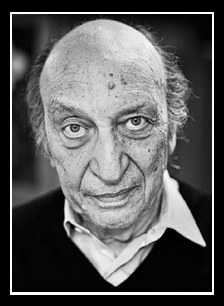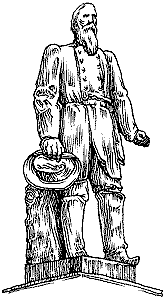Maybe I was never on “Captain Kangaroo,”
but, dangit, I could’ve been!
August 5th, 2020
“To straddle that fundamental duality is to be balanced: to have one foot firmly planted in order and security, and the other in chaos, possibility, growth and adventure. When life suddenly reveals itself as intense, gripping and meaningful; when time passes and you’re so engrossed in what you’re doing you don’t notice — it is there and then that you are located precisely on the border between order and chaos… Order is not enough. You can’t just be stable, and secure, and unchanging, because there are still vital and important new things to be learned. Nonetheless, chaos can be too much. You can’t long tolerate being swamped and overwhelmed beyond your capacity to cope, while you are learning what you still need to know. Thus, you need to place one foot in what you have mastered and understood and the other in what you are currently exploring and mastering. Then you have positioned yourself where the terror of existence is under control and you are secure, but where you are also alert and engaged. That is where there is something new to master and some way that you can be improved. That is where meaning is to be found.”
— Jordan B Peterson — 12 Rules for Life: An Antidote to Chaos
Glaser’s “Ten Things I Have Learned”
June 28th, 2020You can only work for people whom you like.
If you have a choice, never have a job.

Some people are toxic.
Avoid them.
The good is the enemy
of the great.
Less is not necessarily more.
Style is not to be trusted.
How you live changes
your brain.
Doubt is better than
certainty.
On aging: It doesn’t matter.
Tell the truth.
Milton Glaser
1929 – 2020
June 11th, 2020
“This growing sense of injustice and unfairness will hit across economies. As the virus bites harder in less developed economies, the pressure and unrest is likely to escalate. As the global economy deteriorates, unemployment rises and inequalities widen, the pressure on governments will mount. Economies in crisis and rising unrest are going to prove a fertile ground for political agitation and populism.”
— Bill Blain — The Morning Porridge
May 31st, 2020
“But at the same time, it is as necessary for me to be as vigorous in condemning the conditions which cause persons to feel that they must engage in riotous activities as it is for me to condemn riots. I think America must see that riots do not develop out of thin air. Certain conditions continue to exist in our society which must be condemned as vigorously as we condemn riots. But in the final analysis, a riot is the language of the unheard.”
— M L King, Jr — Stanford University, April 14, 1967
May 8th, 2020
“No one has ever taken this kind of jackhammer to the economy in such a brief time and shut it down. We just don’t understand whether this is going to take a year or ten years to work out of. Therefore, the prudent thing right now is to hunker down, minimize discretionary spending, build up liquidity, get into cash, and buy gold. There’s no playbook that will tell you where we’re going. We’ve violated all the rules of economic life and monetary rationality that have ever been created over the last centuries.”
— David Stockman — InternationalMan.com
April 21st, 2020
“He had a strong sense of his life being upon the turn, between two seasons, as it were, with the certainties of the one no longer valid for the other. He was not a fanciful man, but for some time now he had had an indefinable sense of chaos following order, of impending disaster; and it oppressed his mind.”
— the thoughts of Captain J Aubrey
Treason’s Harbour by Patrick O’Brian
April 10th, 2020
“The whole aim of practical politics is to keep the populace alarmed (and hence clamorous to be led to safety) by menacing it with an endless supply of hobgoblins.”
— H L Mencken“The projections from the data were wildly off base, but were the basis for this national lockdown. Remember when you hear that social distancing and other measures are why the projections are now being revised down: key data models assumed full social distancing.”
— Brit Hume“I would lift stay-at-home orders except for known risk groups. We already know certain conditions that are predictive of severe disease. Especially since young healthy lungs tend to be resistant, I would let the virus circulate in the population that is not likely to get severe disease from it. This is the only path that comes close to balancing the needs of all groups. Vaccines are not coming anytime soon, so natural immunity is the only way out for now. Every day, every week in the current situation is ruining innumerable lives in a criminally unjust manner.”
— Michael Burry, MD
March 29th, 2020
“And in case anyone still hasn’t figured it out, the whole ‘republican, democrat’ split of the population in two rival camps is nothing more than theater meant to distract while those in control loot not only the here and now, but also rob the future generations blind. Because the sad truth is that behind the fake veneer of either progressive ideals of conservative values, politicians on both sides have one simple directive: to perpetuate the broken status quo for as long as humanly possible, and get as rich as possible in the process.”
— ‘Tyler Durden’ — ZeroHedge.com
Loving her from a distance . . .
March 20th, 2020

I’m pleased that Dana and I were able to visit Mombo at ‘The Grandview’ in Campbellsville, before the facility was locked down as part of the pandemic response. Jerome is now the only member of the Clan who can enter the building. There was a time when she would’ve been vitally interested in all the daily developments and whether or not we’re on the verge of a potential “Crash” (an ongoing topic of discussion in our family for decades).
March 19th, 2020
“There is no precedence for the situation we are facing now. An epic battle of humanity trying to combat a new virus for which there is no cure and still no all clear signal, a global asset price collapse at the end of an aging and highly indebted business cycle and central banks with limited ammunition desperately trying to regain and maintain control. … I think all the excess and reckless monetary policies of the past 11 years are directly responsible for the severity of this crash.”
— Sven Henrich @NorthmanTrader
March 6th, 2020
“When we kill women in our stories, we aren’t just annihilating female gendered bodies. We are annihilating the feminine as a force wherever it resides — in women, in men, of the natural world. Because what we really mean when we say we want strong female leads is: ‘Give me a man but in the body of a woman I still want to see naked.’ … I don’t believe the feminine is sublime and the masculine is horrifying. I believe both are valuable, essential, powerful. But we have maligned one, venerated the other, and fallen into exaggerated performances of both that cause harm to all. How do we restore balance?”
— Brit Marling 2/7/20
February 23rd, 2020
“The advent of civilization is a wonderful thing. It creates leisure. It creates material wealth, luxury. It’s civilization. It’s not tribalism. It’s not barbarism. But in that process, we become tame, and yet the world around us is not tame, and we don’t quite know how to justify using violence against people who want to kill us.”
— Victor Davis Hanson 2/13/20
November 30th, 2019
“The essential cultural discrimination is not between having and not having or haves and have-nots, but between the superfluous and the indispensable. Wisdom, it seems to me, is always poised upon the knowledge of minimums; it might be thought to be the art of minimums.”
— Wendell Berry — from The Hidden Wound
50 Years
July 20th, 2019back on the trail
July 2nd, 2019“Forget about the knee. It didn’t happen. Get on with it. Put it behind you.”
— James D Dixon
Yesterday I was in Yellow Springs again, to observe the close of a cycle that began with the unlikely combination of an 80-mile bicycling weekend for my 66th birthday and the follow-up knee injury after Derby Day, while I was washing my truck.
OK. Now the abnormal year is behind me, and I was back at the Little Miami Scenic Trail to walk and to declare it over and done with!
censorship of art
June 28th, 2019This is Wendell Berry’s must-read 2015 editorial about art censorship:
hatless guy of stone whom I sketched, once upon a time
June 24th, 2019“When fascism comes to America, it will not be in brown and black shirts. It will not be with jack-boots. It will be Nike sneakers and Smiley shirts.
— George Carlin
I first noticed the statue in McDowell Park about the time I started to walk around Danville after we got the Town House. There was something about the artistic interpretation that appealed to me — not entirely realistic, but only slightly abstracted from life, perhaps like the way I might draw something. I reacted to it as sculpture before I thought much about it as a Confederate symbol. Eventually I did draw it. I don’t remember the year, although I could look it up. At any rate, it was a long time before tragic events were used as an excuse to denounce antique works of art. As soon as they were condemned elsewhere, I thought, “Danville seems immune to such things, but it’s only a matter of time before that statue becomes a target for destruction or removal.” My recent conversation with a local artist has informed me that the day has finally arrived. The decision to spend a lot of money to truck it off apparently has sparked a firestorm within the church congregation with jurisdiction over the statue, which is probably about a hundred years old. I once heard that it’s the northernmost Confederate memorial, but I can’t see how that would be possible. It is understandable that with the Perryville Battlefield only a few miles away, and the history of the conflict’s effect on Danville, that there would be a monument here to honor dead CSA soldiers. More than that, it is a work of art. Period. It was created as such, and is part of of American, Kentucky, and Danville history. It makes sense to preserve it, to conscientiously interpret it, and to put it into the context of the times. Some are certain to have found it offensive, most likely from the time it was erected, and I can respect that, but it is very dangerous territory to use that as justification for the censorship or desecration of art. The whole thing brings a wave of sadness over me. I doubt that those who oppose the decision will successfully swim against a strong tide of political correctness. When the relocation takes place, I hope it ends up north of town, over at the Danville National Cemetery, near the graves of southern men who were buried far from their homes.
My recent conversation with a local artist has informed me that the day has finally arrived. The decision to spend a lot of money to truck it off apparently has sparked a firestorm within the church congregation with jurisdiction over the statue, which is probably about a hundred years old. I once heard that it’s the northernmost Confederate memorial, but I can’t see how that would be possible. It is understandable that with the Perryville Battlefield only a few miles away, and the history of the conflict’s effect on Danville, that there would be a monument here to honor dead CSA soldiers. More than that, it is a work of art. Period. It was created as such, and is part of of American, Kentucky, and Danville history. It makes sense to preserve it, to conscientiously interpret it, and to put it into the context of the times. Some are certain to have found it offensive, most likely from the time it was erected, and I can respect that, but it is very dangerous territory to use that as justification for the censorship or desecration of art. The whole thing brings a wave of sadness over me. I doubt that those who oppose the decision will successfully swim against a strong tide of political correctness. When the relocation takes place, I hope it ends up north of town, over at the Danville National Cemetery, near the graves of southern men who were buried far from their homes.
Each time the Taliban or other radical groups obliterate Buddhist artworks deemed objectionable, it would appear to a reasonable person, on the face of it, as an abomination. When art historian Robert Hughes describes Stalin’s repression of the Russian avant-garde after 1930, he writes that, “as a wholesale trashing of a civilization, only Hitler’s demolition of the German modernists compares with it.” Although I’m not holding my breath, it will remain my hope that American culture warriors with a self-righteous upper hand are not embarking on an enterprise that people in the future will classify as yet another ideological outrage.
kia walaia
June 18th, 2019I’ve reached page 179 of In Search of Robinson Crusoe and Tim Severin finally brings tears to my eyes with his description of Marco’s farewell (kia walaia, which translates from Miskiti as “to smell, to understand”). An adequate substitute for O’Brian this summer, I discovered this writer and true-life adventurer while cutting up an old Outside magazine. When I finish this, I must find his book on the North Atlantic voyage of Saint Brendan, a feat which Severin dangerously re-enacted with an authentic skin-covered boat.
• When I thought, “What is the purpose of all this?” as I was taking care of a completely disoriented and feeble Mombo, the only possible answer is what John Paul II called “the law of the gift” — the giving of oneself as the path to true happiness. It aligns with the single greatest of commandments, to love. But it also requires the conscious awareness, consent, and acceptance of the giver, or the gift becomes something else, and can be perverted so readily into resentment, or the sense of injustice. And so, it is not just the doing. It must be the mindfulness behind it, too.




